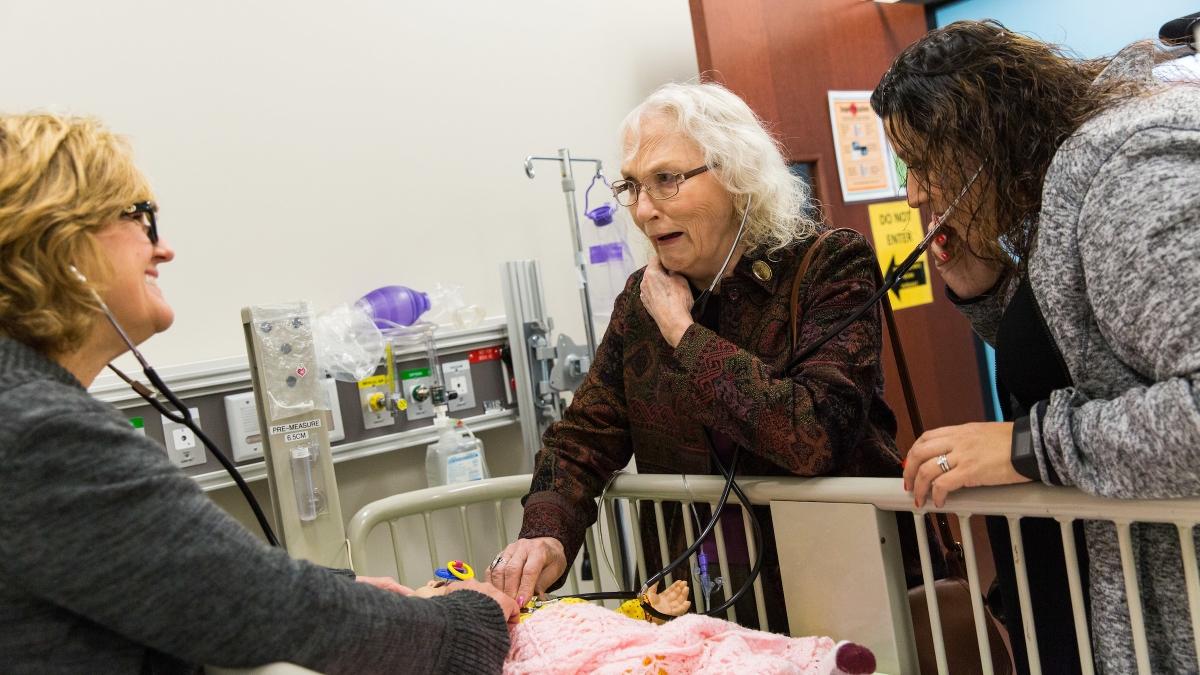In learning, practice makes perfect. In learning health care, it’s best if that practice doesn’t put patients at risk.
That’s the idea behind ASU’s 15-year-old Simulation and Learning Resources Center, where College of Nursing and Health Innovation students get hands-on clinical experience with minimal risk because the patients are either actors or uncannily lifelike mannequins.
The center’s method has been so successful that it recently expanded by 40,000 square feet — doubling its previous space. “And we’re not done yet,” said center co-founder Beatrice Kastenbaum.
Kastenbaum, clinical associate professor, said the simulation learning method is invaluable for students and community members, who later benefit from more experienced nurses and doctors. Without it, she said, students must rely solely on live experience in settings where they’re only allowed to observe.
Using actors and mannequins, said Bertie Estrada, clinical assistant professor and simulation nurse specialist at the center, allows students “to make mistakes without repercussions.”
On Friday, Estrada joined fellow CONHI faculty and colleagues at the Downtown Phoenix campus for an open house and ribbon-cutting ceremony.
Simulation and Learning Resources Center representatives celebrate with ASU College of Nursing and Health Innovation Dean Teri Pipe (center) at the grand opening Friday that marked a 40,000-square-foot expansion on the Downtown Phoenix campus. Photo by Deanna Dent/ASU Now
The facility now accommodates four simulation suites with nine patient rooms and six clinic rooms, four skills labs, a health assessment lab and a computer library.
At the ceremony, CONHI Dean Teri Pipe thanked former director Ruth Brooks and Kastenbaum, who together founded the center.
It was their advocacy, Pipe said, that led to the creation of “this amazing place [that exists] with the health and well-being of our community in mind” and helps students “emerge with excellence in their career.”
Pipe also thanked the many benefactors present, “without whose philanthropic donations this would not be possible.”
The expansion began in June, but center director Margaret Calacci — who took over in July — said it had been almost 10 years coming.
Calacci said that it is her goal “to continue to prepare students for a career in health care with this state-of-the-art facility, which provides an environment where they can develop clinical thinking and reasoning through safe practice.”
Among the added features are a range of different types of care environments: traditional doctor and hospital rooms as well as an apartment-like setting, where students can get a feel for what it’s like to give in-home care.
Within those environments, students can hone their skills by providing care for medical mannequins that exhibit “pretty much everything you’d want to monitor on a patient,” according to Shannon Brock, a simulation nurse specialist at the center.
Students can take the mannequins’ blood pressure and temperature, and measure their heart rate and oxygen saturation levels, among other things.
The mannequins — which can blink, breathe and talk — are controlled via computers by clinicians.
In other settings, such as a generic doctor’s office, students can interact with live patients in the form of actors, who are either community volunteers or ASU acting students.
Nursing grad student Lillian Chang said the opportunity to get “immediate feedback from an actual, live patient” in a safe, controlled environment is both unique and extremely helpful for students.
CONHI alum Kurt Brownsburger, who now works at Banner Thunderbird Medical Center in Glendale, had attended a few different schools before coming to ASU, where he spent several hours training at the Simulation and Learning Resources Center.
He noticed a huge difference from what was “almost purely lecture-based” learning to the center’s “much more integrative model.”
“It’s very realistic,” he said, “and you really get to see what works and what doesn’t, while being free to make mistakes. You can reset a mannequin; you can’t reset a human.”
Top photo: ASU alumni Norine Heinrich (center) and Marissa Starks-Banh (right) get a demonstration of mannequin "Victoria" by ASU clinical faculty Leann Dykstra during the grand opening of the Simulation and Learning Resources Center on Friday. The center has undergone a 40,000-square-foot expansion, doubling its previous size. Photo by Deanna Dent/ASU Now
More Health and medicine

Have a health question? This newsletter is for you
You sprain a knee while playing basketball. Your stomach hurts all the time. You keep getting bad headaches.What’s the first thing you do, besides making a doctor’s appointment?If you’re like most…

Spring clean your social life
Spring: a season of growth, warmer weather and perhaps a case of the sniffles. But as much as the flowers are budding and blooming, so should — hopefully — our social connections. Or are they…

Putting health first: ASU experts doing research that improves lives and gets results
Arizona State University isn’t just studying the topic of health. It’s applying what is taught and learned to make a real difference in people’s lives.Whether it’s working with community partners to…



